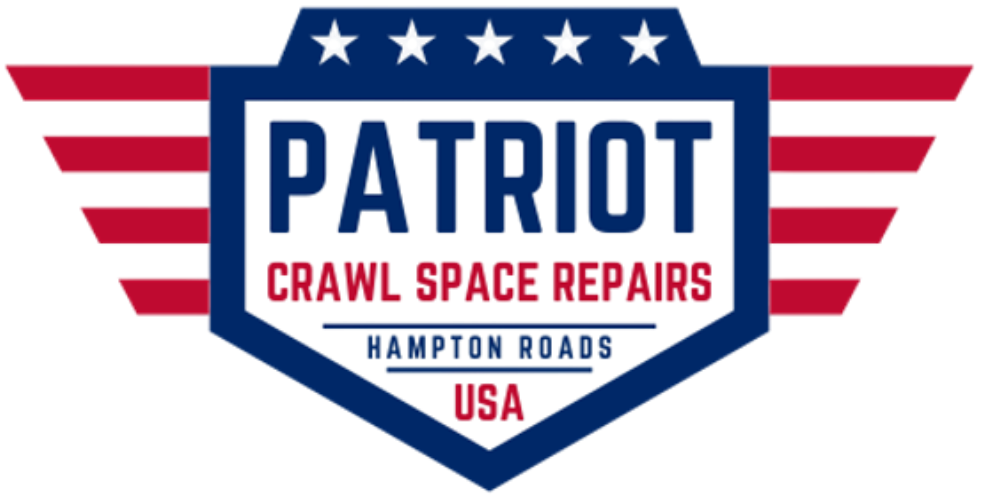The Crawl Space Blog
Expert information and advice on everything crawl space related.
Watch The Youtube Video
The #1 Cause of Crawl Space Moisture: Condensation

Most homeowners assume crawl space moisture comes from the ground. But in reality, the #1 cause is condensation — humid air turning into liquid water when it hits cooler surfaces under your home.
At Patriot Crawl Space Repairs, we’ve inspected thousands of crawl spaces across Hampton Roads. Time and again, we find that musty smells, mold, and soft floors come from condensation, not groundwater.
What Is Crawl Space Condensation?
Condensation is basic physics. Warm air holds more moisture than cold air. When humid air enters a cool crawl space through vents, gaps, or an unsealed door, it cools down.
Once it drops below its dew point, that moisture in the air turns into water droplets — just like a cold drink sweating on a summer day.
Those droplets form on ducts, pipes, insulation, and wood framing. Over time, that moisture soaks into wood, raises humidity levels, and keeps the space damp year-round.
Where Condensation Collects
Condensation often forms on:
• Metal ducts and pipes that cool below the dew point
• Wood joists and subflooring that absorb moisture
• Fiberglass insulation that traps humidity
• Concrete or block walls that stay cooler than the air
Even if there’s no standing water, humidity from condensation can keep the entire crawl space damp.
The Damage Condensation Causes Mold and Mildew
When humidity stays above 60%, mold starts to grow. Condensation gives it the moisture it needs to spread across joists, insulation, and walls. The moldy air then rises into your living space through the
stack effect, carrying odors and allergens.
Wood Rot and Structural Weakness
Wood absorbs moisture from the air. When it stays damp, the fibers break down — causing soft floors, sagging joists, and cracked drywall.
Wet or Fallen Insulation
Fiberglass insulation acts like a sponge. Once it’s wet, it collapses, traps moisture, and loses efficiency.
Rust and Corrosion
Cold metal ductwork and hangers “sweat,” leading to rust and early HVAC damage.
Poor Air Quality and Higher Energy Bills
About half the air inside your home comes from the crawl space. Damp air increases energy use and spreads odors throughout your home.
Why Crawl Space Vents Make It Worse
For decades, builders thought crawl spaces needed vents to “breathe.” But in our humid Virginia climate, vents let moisture in, not out.
When warm outdoor air enters a cool crawl space, it drops below the dew point and releases water. Instead of drying the area, it adds moisture to it.
That’s why modern building science recommends sealed, conditioned crawl spaces instead of vented ones.
How to Stop Condensation for Good
The key to stopping condensation is to control humidity and airflow — not just cover the dirt.
1. Seal Air Leaks and Vents
Close off vents, doors, and gaps so outdoor air can’t enter.
2. Install a Crawl Space Dehumidifier
Maintain humidity between 45–55% to prevent condensation and mold growth.
3. Lay a 10-Mil Vapor Barrier
Cover the ground with a 10-mil vapor sheet to block slow moisture vapor from the soil.
4. Add Drainage Only If Needed
If you have standing water, install a perimeter drain and sump pump to handle groundwater separately.
5. Insulate Ducts and Pipes
Cold surfaces attract condensation. Proper insulation prevents “sweating.”
When Full Liners Make Sense
We’re not against full liners — they have their place. In taller crawl spaces (30 inches or more), where homeowners want storage or a clean look, wall liners add value.
But in low-clearance crawl spaces, a full liner is usually unnecessary. A sealed space with a 10-mil vapor barrier and a dehumidifier performs just as well — at a lower cost.
The Benefits of Fixing Condensation
• Dry, solid floors — no more sagging or soft spots
• Cleaner indoor air — fewer odors and allergens
• Better energy efficiency — less strain on HVAC
• Longer lifespan for ducts, insulation, and wood framing
• No musty smells or mold growth
You’re not just fixing your crawl space — you’re improving the health and comfort of your entire home.
The Patriot Crawl Space Repairs Difference
We don’t sell one-size-fits-all systems. We diagnose the real problem and fix it with science-based solutions.
During your inspection, we:
• Measure humidity and wood moisture
• Identify condensation points and air leaks
• Evaluate drainage and insulation
• Design a long-term plan to keep your crawl space dry
We believe in fixing the source, not the symptoms.
Bottom Line
Condensation is the #1 cause of crawl space moisture — and it’s completely preventable. When humid air meets a cool surface, it turns into water that fuels mold, rot, and poor air quality.
By sealing vents, installing a dehumidifier, and adding a 10-mil vapor barrier, you can stop condensation before it starts.
If your crawl space smells musty, your floors feel soft, or your insulation is falling, you’re not dealing with groundwater — you’re dealing with condensation.
📞 Call Patriot Crawl Space Repairs or visit patriotcrawlspacerepairs.com to schedule your crawl space inspection today.



